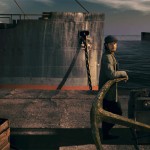Gebo and the Shadow
Dir. by Manoel de Oliveira
I won’t pretend I know anything about Raul Brandão beyond what I’ve just learned from his Wikipedia page — that he became a journalist while working in Portugal’s Ministry of War, that the most productive period in his writing life came after retiring from that career, that he’s an important figure in Portuguese Modernism. Gebo and the Shadow, the latest film from 103-year-old Manoel de Oliveira, is as far as I can tell an adaptation of one section of Brandão’s 1923 novel, Os Pescaderos, a sympathetic study of the beautiful and tragic lives of the hard-working residents of various fishing villages.
Although Brandão is a generation older than Eugene O’Neill, de Oliveira’s film plays out like A Long Day’s Journey into Night. Stagy even compared with de Oliveira’s other recent work, Gebo and the Shadow is built from several long, late-night conversations that lead inevitably toward ruination. “It was you and her that bound me to life,” Gebo (Michael Lonsdale) tells his wife Doroteia (Claudia Cardinale), and in that one line is contained all of the film’s tragedy. The daily labors of life, the lies and deceptions, the sacrifices — Gebo’s every action is made in despairing love and generosity for Doroteia and their daughter-in-law Sofia (Leonor Silveira).
Cinematically, Gebo and the Shadow is a fairly simple film. (I heard one other critic at TIFF refer to it as a script table-read.) The opening moments are fantastic, though. The first shot (shown above) is an unnaturally lit, not-quite-realistic image of Gebo’s son João (Ricardo Trepa), who we see in profile, his face and body casting black shadows. (This allusion to the film’s title is obvious to me only in hindsight.) After a quick, impressionistic recreation of one of João’s crimes, de Oliveira cuts to the small room in which nearly all of the remainder of the film occurs. Sofia stands in front of a window, illuminated by candlelight, and as the camera dollies, we catch a glimpse of Doroteia in reflection. It’s a lovely shot that reveals the full physical space in which the characters exist, while also setting up the female leads as mirror images of one another. An especially nice touch is that the first image of Doroteia is blurred. At first it’s possible to mistake her for a literal reflection of Sofia, one of the film’s many reminders of the passage of time. (No reminder is more shocking than watching the aged faces of Cardinale and Jeanne Moreau.)
differently, Molussia
Dir. by Nicolas Rey
Nicolas Rey introduced differently, Molussia with a long quotation from an essay by Günthers Anders in which Anders critiques the common usage of the word “totalitarian.” Rather than an adjective by which one speaker defines himself in opposition to another (it’s always the other power or system that is “totalitarian”), Anders argues that totalitarianism is instead characterized by its “sense of the machine.” “What can be done, needs to be done,” he writes. Once a technique is discovered, it will be marketed until a need for it is created, which can then be exploited for profit. Resistance, as they say, is futile. Rey smirked while quoting Anders again during the Q&A: “Nothing discredits a man more quickly than critiquing a machine.”
The essays Rey quoted were written some thirty or forty years after his only novel, The Molussian Catacomb (1932-36), a collection of brief, witty, and incisive conversations between prisoners in an imaginary fascist country. Rey’s remarkable adaptation is built from nine reels of hand-processed 16mm film and shown in random order (making 362,880 possible versions of the film). Each includes a voice-over reading of a passage from one chapter of the novel, juxtaposed against images of landscapes, a soundtrack that mixes machines and natural sounds, and occasional portraits of the residents of Molussia (most of the film was shot within close driving range of Rey’s home near Paris). My interview with Rey and a much longer write-up about the film will be included in the next issue of Senses of Cinema.
Night Across the Street
Dir. by Raul Ruiz
Long John Silver, rhododenrons, retirement parties, desert landscapes, Beethoven, pink walls, mysterious assassins, four-letter words, childhood memories, gun barrels, a beautiful dancer, bicycles, Antofagasta, classroom anxiety, shiny faces, a man who never speaks, ugly video, ships in bottles, a last desperate gasp of life, and ghosts and ghosts and ghosts.
That’s all I’ve got.
Wavelengths 2
More to come in full write-up later this fall.

Comments
2 responses to “TIFF 2012 – Day 3”
So, it sounds like you would NOT recommend Ruiz’ film? Is it that bad?
Dan, Ruiz was credited with directing 115 films, I’ve seen five or six of them, and Night Across the Street is often described as a kind of swan song that revisits many of his life-long obsessions, most of which were lost on me. A friend who is more familiar with Ruiz’s work and who likes this film quite a bit told me he really enjoyed reading my strange little haiku of a response — for what that’s worth. It’s definitely not a bad film, but I can imagine it being a very frustrating viewing experience if it’s your first experience of Ruiz.